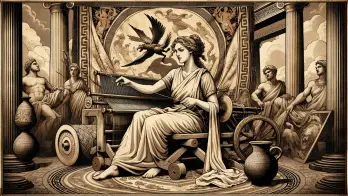Amun (also Amon, Ammon, Amen, Ra) was one of the most important Gods in Ancient Egyptian religion, worshipped throughout the land for over three thousand years.
Who Was Amun, the Sun God?
Traditionally, Amun was often depicted as a man with the head of a falcon or a ram, representing his dual nature as both a solar and fertility God.
This revered deity rose to fame during the New Kingdom period (c. 1570-1069 BC) in Thebes, where his cult became the most popular and influential in Egypt.
His name was derived from the word “Amen,” meaning hidden or concealed, and “Ra,” the Sun God, which reflected his role as the hidden force behind the Sun’s daily journey across the sky.
Unlike other gods in the Egyptian pantheon, he was believed to encompass all aspects of creation and was known as Lord of All.
Along with his consort Amaunet, he was a part of the Ogdoad, eight gods who represented the primordial elements of creation.
At the time, the supreme god of Thebes was the war god Montu, and the creator god was regarded as Atum (also known as Ra).
Although he was not more powerful than the other gods in the Ogdoad, he represented the element of “hiddenness” or “obscurity.” This meant that people could define him according to their understanding of what they needed him to be.
Unlike other gods, who were associated with specific concepts such as “darkness,” “water,” and “infinity,” Amun represented the mysterious hidden nature of existence.
This made him an all-encompassing deity who could lend himself to any aspect of creation.
An Ancient Egyptian Deity
The worship of Amun, an ancient Egyptian deity, can be traced back to the Old Kingdom period, between 2686-2181 BC.
At that time, Amun was a local god in Thebes, but as time passed, his popularity grew, and he was eventually assimilated into the national pantheon.
During the New Kingdom period, between 1550-1069 BC, Amun became the state god of Egypt, and his cult grew to become the most powerful in the land.
However, around 1800 BC, the Hyksos, a group believed to have originated from the Levant region, migrated to Egypt and settled in the country.
By 1720 BC, the Hyksos had gained enough power to conquer Lower Egypt and render the Theban court obsolete. This era, known as The Second Intermediate Period, lasted from 1782 BC to 1570 BC, during which the Hyksos ruled Egypt.
In 1570 BC, Prince Ahmose I led a successful campaign to drive the Hyksos out of Egypt and re-established the city of Thebes.
Since the Middle Kingdom period, Amun gained power in Thebes and was part of the Theban triad of deities, including his consort, Mut, and their son, Khonsu, the moon god.
When Ahmose I defeated the Hyksos, he attributed his triumph to Amun, linking him to the well-known sun god, Ra.
As the god was associated with no definable natural phenomenon or principle, he was flexible enough to incorporate any attribute one wished to add to him.
In this case, the mysterious aspect of life, the essence of existence, was linked to the visible life-giving aspect of the universe: the sun. As a result, Amun became Amun-Ra, the creator of the universe and King of the Gods.
The god underwent an evolution from a local deity to a national god, which occurred due to the events that took place during Egypt’s history.
He’s importance in Thebes grew, and his association with the sun god Ra made him one of the most powerful deities in the Egyptian pantheon.
The King of the Gods
During the New Kingdom, the sun god rose to prominence as “The Self-created One” and “King of the Gods.” He was believed to have created everything, including himself.
Amun was closely associated with the sun god Ra, who had earlier been associated with the god Atum of Heliopolis.
Although he absorbed many of Atum’s attributes and replaced him to a large extent, Atum remained a distinct deity and continued to be worshipped.
In his role as Amun-Ra, the god combined his invisible aspect (symbolized by the wind, which cannot be seen but is felt) and his visible aspect as the life-giving sun.
Amun brought together the most important aspects of Ra and Atum to create an all-encompassing deity whose aspects represented every facet of creation.
His popularity was so great that, according to scholar Richard H. Wilkinson, Egyptian religion became almost monotheistic, and Amun “came particularly close to being a kind of monotheistic deity.”
In fact, the cult of the sun god inspired the first monotheistic religious movement in Egypt, under Akhenaten (1353-1336 BCE). Akhenaten banned polytheistic worship and established the state religion of the one true god, Aten.
While Akhenaten’s efforts have been viewed as a genuine attempt at religious reform, his motivations were likely influenced by the wealth of the Priests of Amun.
At the time of Akhenaten’s accession to the throne, the priests held more land and greater wealth than the pharaoh.
Amun Family Tree
Amun was among the most important gods in ancient Egyptian mythology, often considered the “king of the gods.”
His family tree includes the following:
Parents: His parents are not clearly identified in Egyptian mythology. Some sources suggest that he was the son of the god Ptah and the goddess Sekhmet, while others say that he was the offspring of the god Min and the goddess Mut.
Consorts: The sun god had several consorts, including the goddess Mut, who was also his mother in some traditions. He was also often associated with the goddess Hathor, who was seen as his wife and the mother of his children.
Children: The god had several children, including:
- Khonsu – the god of the moon and time;
- Montu – the god of war and strength;
- Tefnut – the goddess of moisture and fertility;
- Sobek – the god of crocodiles and fertility;
- Anubis – the god of mummification and the afterlife.
Myths & Legends
Amun was one of the most important gods in the ancient Egyptian pantheon, and he was worshipped as the sun god and was believed to have control over life, death, and the afterlife.
As with many ancient deities, numerous myths and legends were associated with Amun.
One of the most enduring myths of the sun god was his daily journey across the sky.
According to legend, Amun would travel through the underworld at night, battling the serpent Apep to ensure the Sun would rise again the next day.
The battle between Amun and Apep was seen as a metaphorical struggle between good and evil, order and chaos.
The Egyptians believed that Amun’s victory over the serpent was essential for the world’s survival and that his power over darkness and chaos allowed the world to exist in a state of harmony.
Another important myth surrounding the King of Gods was the story of his creation. He was believed to be self-created, emerging from the primordial waters at the beginning of time.
This gave him a unique status among the Gods, as he was seen as the ultimate creator and source of all life.
The myth of Amun’s self-creation emphasized his omnipotence and ability to create order out of chaos.
Ancient Egyptians also believed that his power was so great that he could create the universe simply by speaking it into existence.
The Cult of Amun
Amun, the divine pharaoh, was the central figure of the Cult of Amun, which became the most revered and influential religion in ancient Egypt’s New Kingdom period.
The sun god was believed to be omnipresent and communicated his will to humanity through his oracles. He was also known to help Egyptian kings and the needy in battle.
The Temple of Amun at Karnak, located in Thebes, was the main place of worship for the god. It was the largest religious structure ever built, and its ruins and other associated temples dedicated to the sun god can still be seen today.
His cult was so influential that it sparked the first monotheistic religious movement in Egypt under Akhenaten, who established Aten as the state religion.
Akhenaten’s motives for the religious reforms were likely influenced by the immense wealth and power held by the Priests of Amun, who owned more land and possessed greater wealth than the pharaoh.
Despite Akhenaten’s efforts, the cult of Amun remained one of the most significant in Egypt until the end of the pharaonic era.
Amun’s floating temple, known as Amun’s Barque or Userhetamon, was an impressive work created in his honor.
It was gifted to Thebes by King Ahmose I, covered in gold from the waterline up, and filled with cabins, obelisks, niches, and elaborate adornments.
On special occasions, such as the Feast of Opet and the Beautiful Feast of the Valley, the barque would carry the god’s statue from the Karnak temple downriver to the Luxor temple with a grand ceremony.
The power and wealth of the priests of Amun eventually surpassed that of the king, and religious reforms were introduced in an attempt to curb their power.
However, these reforms were largely ineffective. Akhenaten initiated dramatic religious reforms, but they had no significant impact on the cult of Amun.
After Akhenaten’s death, Tutankhamun became pharaoh and reinstated the old Egyptian religion, opening all temples.
General Horemheb raised the old gods to their former heights and obliterated the memory of Akhenaten and his family from the historical record.
Despite this, some scholars suggest that Moses, the great Hebrew law-giver, was a priest of Aten who left Egypt with his followers to establish a monotheistic community elsewhere.
Amun's Enduring Legacy
After Horemheb’s reign, the cult of Amun remained popular and gained widespread acceptance during the 19th Dynasty of the New Kingdom.
By the Ramessid Period (c. 1186-1077 BC), the priests of Amun had amassed enough power to rule Upper Egypt from Thebes as pharaohs.
This, in fact, contributed to the fall of the New Kingdom. Even as the Cult of Isis gained more followers during the Third Intermediate Period (c. 1069-525 BC), his cult continued to exert its control from Thebes.
Ahmose I elevated the practice of consecrating royal women as “divine wives of Amun” who would participate in festivals and ceremonies.
This office of God’s Wife of Amun was turned into one of great prestige and power under his rule.
Later, the Kushite kings of the 25th dynasty continued this practice, leading to a resurgence in the worship of the sun god as the Nubians accepted him as their own.
Even after Thebes was sacked by Ashurbanipal in 666 BC, Amun remained widely worshipped throughout Egypt.
He was regarded as an advocate of the common man and the protector of travelers.
Queen Hatshepsut legitimized her reign by claiming Amun as her father. Alexander the Great did the same at the Siwa Oasis, proclaiming himself a son of Zeus-Ammon.
Although his popularity declined as Isis gained more followers in Egypt, he remained worshipped regularly at Thebes. His cult became powerful and wealthy enough to enforce their will on the kings of Meroe, a region where his worship took hold.
King Ergamenes of Meroe broke ties with Egypt and established an autonomous state by massacring the priests of Amun in c. 285 BC.
Despite this, Amun continued to be revered as a potent deity in Meroe and elsewhere.
His cult would continue to attract followers well into the period of classical antiquity (c. 5th century AD) until Christianity supplanted the old gods.
At Ancient Theory we only use trusted sources to document our articles. Such relevant sources include authentic documents, newspaper and magazine articles, established authors, or reputable websites.
- Deities in Ancient Egypt - Ra. egyptianmuseum.org.
- Amun. wikipedia.org. [Source]
- George Hart - The Routledge Dictionary of Egyptian Gods and Goddesses. Routledge, 2005.
- S. Quirke - The Cult of Ra: Sun-worship in ancient Egypt. Thames and Hudson, New York, 2001.
- Melissa Hessing - Amun-Ra: The Chief God of Egypt. [Source]






